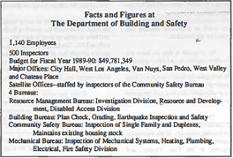Understanding the Building and Safety Department is a crucial component of the development process in Los Angeles. The Planning Report recently met with Warren O’Brien, General Manager of the Department. O’Brien was appointed to the post this past June, having served 28 years in the Department, the past 5 as Executive Officer under General Manager Frank Kroeger.
What is your workload at the Department of Building and Safety?
We have roughly 1,100 employees. It’s probably the fourth largest department in the city—we are twice as large as the Planning Department. And we have an extremely large work load. We issue approximately 70,000 building permits each year. Those permits are for all types of construction including new renovations on all buildings. We also issue 120,000 mechanical permits for areas ranging from plumbing and electrical to beams and air conditioning. We do a very large volume of work.
And our work load continues to increase dramatically; it seems to be increasing about 20% a year in the last 5 or 6 years. It's unbelievable. We continually get predictions that the economy is going to slow down, that construction is going to slow down. Every year about this time we hear predictions made by UCLA about what will happen in the state and the nation. Every year reports show either a leveling off, or a reduction in housing construction.
But ever, year we get a 20-25% increase. Regardless of these predictions, they don't affect us. The city of Los Angeles is a hot bed for construction. I think the economy keeps growing and growing. It's not going to slow down. New construction in the city was valued at $4.3 billion last year.
Has your department been increasing by 20% as well to handle the work load?
Not exactly, it never quite works that way. The department has been increasing but with each increase in the department comes another program to undertake. That is the mechanism by which we get most of our increase. In six years we have added about 400 people to the department. But most of those people were for new programs.
For instance, we added a new program for the disabled people of the community to get access to buildings. We added 37 people to our staff for the program, enforcing the ordinance for disabled access. The problem we had was that the plan checkers are engineers. Many of them are licensed engineers. And it's very difficult to get a plan checker, when you are rushing them through a job, to think that the height of a toilet is as important as the size of a beam or a truss. It's just natural, very natural for an engineer to say, “Well, if I can only check one or the other, I'm going to check the truss.” And, that got us in trouble. We realized it was a problem, and created the division several years ago.
There are several programs currently being considered which will continue our growth as a department. One new ordinance will require us to monitor auto repair garages. Six or seven new employees will be responsible for enforcing regulations so that these garages do not continue to repair cars out in the open or store cars in their lots. Every year we will go out and inspect every auto repair garage in the city to make sure they're complying with the laws—they can be a serious blight on the neighborhood.
The list of new programs goes on and on. That's how we keep growing. What I see for the department in the future is getting more involved in social issues—housing, affordable housing, illegal housing, converted garages, and making sure that housing is legal.
Has the Department or Building and Safety traditionally dealt with these social issues?
Yes, we regulate the zoning laws of the city of Los Angeles and always have. The Planning Department writes them and we enforce them. But the direction that this department is taking is for pro-active measures and social measures. We are asked to undertake some projects instead of the Police Department because we have the authority to go on private property. That's why the City gives us all these programs—it's much easier for us to go on private property. Therefore our Operation Knockdown will demolish vacant or abandoned buildings if they are being used for drug deals. We have demolished 40 since January.
The other issue that we're going to get very involved in is the issue of hazardous materials. The state is starting to rattle our swords about hazardous materials because it exacerbates the ozone problem. It will now be part of the plan check process. When builders come in for a permit, we have a statement on the application that asks them if they have any hazardous materials. If they do, the Air Quality Management District will make sure they have the proper air filtering system and smoking system before we issue a permit. In addition, the Fire Department has a yearly inspection of commercial sites during which time they investigate any hazardous materials.
What do you think is the perception of the Building and Safety Department from contractors and architects?
I think the more professional people understand what we are doing and recognize what is needed. I think the general public may bad mouth the city and its employees. But our employees work hard. We have a lot of ordinances to enforce, and it’s very difficult sometimes for people to understand that when they come for a permit which takes 1 ½ hours and they think that’s the end of the world. They don’t appreciate that we give them the permit over the counter. They can get the permit while they’re here, and they don’t have to come back.
In most jurisdictions that’s not true, and they have to leave the plans. So I think we do a very good service. I think what we need to do is improve our image by bringing the service closer to people.
The creation of the satellite offices tremendously improved the image of our inspectors for residential buildings. We opened 22 or 23 satellite offices which inspectors work out of, instead of simply Downtown, Van Nuys and West L.A. Now the inspectors, for the most part, are very close to their areas and can make more calls. For the local homeowners who do not know that much about construction and are very impatient, they need us the most. By placing the inspector near homeowners makes it more convenient; they can go down to an office and talk to the inspector in the afternoon if the homeowner has a problem. We just opened an office on Chateau Place near Hollywood for plan checking purposes; people don't have to always go Downtown.
In addition, we are providing permit service citywide. If l need a permit in El Sereno, I can go to West Valley or Van Nuys for a permit anywhere in the city.
Numerous architects feel that there is a problem of accountability in your department between plan check and the inspection staff; people's plans are approved, deals are concluded, and everything is approved in the plan check. But the inspectors don't necessarily acknowledge what had happened previously. They just have their own set of rules and biases which is very frustrating for architects and contractors. Have you found that to be the case?
Well, I don't say that that's never happened. I would be very naive to say that never happened. I think that what they have to understand is that we are dealing with human beings here. We have 1,100 people. If you went out and got two different architects to make a decision on a plan, you would get two different opinions. We do try very hard to standardize our Plan Check. The theory is that the plan check function is supposed to establish or check the plans for compliance with the code. We are a monitoring system for the industry.
The architects and engineers are supposed to know what the code says. They are not supposed to rely on us when, in fact, many of them do. They turn in the basic plan and rely on the correction sheet. But we endeavor to be a checking service, not a design service. There's a difference. And, consequently, things are missed in Plan Check. But, that doesn't give the architect or the engineer a license to break the law. It's their responsibility as professionals to know the code. Once in a while the checker will miss something and an inspector will pick it up. But the fact remains that the law is there and has to be complied with whether the Plan Checker missed it or not.
It's an unfortunate problem when it happens, and sometimes it’s disastrous if it's a major problem. That, in fact, is why the Disabled Access Division was created. We were having a terrible problem getting compliance when the plan checker was not regulating, the architects weren't drawing disabled access on the plans, and then the inspector sees the oversight and has no idea what to do. Now that's a major problem. The guy wants to open the store and you tell him, “there’s no disabled access to this building and you need a 30 foot ramp before you can open the store.” So, we created the Disabled Access Division.
What is the waiting time now for plan check? Is there an average waiting time if I submit my plans as a homeowner?
Probably around 30 days.
Let’s say I was building a house on raw land.
It would probably take six weeks.
Let's say I was adding 500 square feet to a house.
That would probably take you a week and a half unless they could do it over the counter. I think they could probably do 500 square feet over the counter. They would do that as a counter check. If you were adding 1,000 of 1,200 sq. ft or a second floor, then they check it on the counter but they take it in and it takes a week or two to check. What we have been doing is working a lot of overtime.
We crank them out pretty fast because we have to. Every week, in order to stay even, we have been receiving between 160 and 180 plans a week. That is how many are filed and that is how many we have to check. And that's where the backlog comes from. We try to keep our normal backlog to 60 days.
What advice would you give to people who use the construction services center?
Well one thing people don't realize is that we are not the sole agency at the constructions services center. That center is coordinated by many agencies. As a result we don't get credit for some of the more efficient innovations, but the problems at the center are not necessarily our fault.
I would say that the most important piece of advice is to come early. The center opens at 7:30 am, and the earlier you get there the better. Also, if you don't know what line you are in, you should ask anybody. You would be amazed at how many people stand in the wrong line. That's one of my priorities—to organize so that people know where they're going. We have designed a new map. But I think the only way to really accomplish that goal is to have a staff person walking around and answering questions. People do not mind standing on line as long as they know they are on the right line.
Finally, I would advise that people should be prepared to answer questions. They should have the legal description of the property and the address, and if they want to expand a building, they will need a plot plan.
- Log in to post comments





